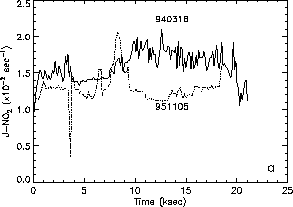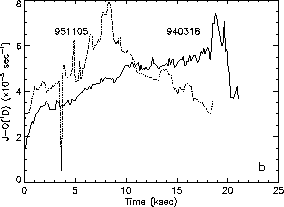| (5.5) |
Due to the wide range of fields and wavelengths measured, a large number of geophysical quantities are potential candidates for retrieval. These are listed below along with the fields used in their retrieval:
Photodissociation rates, or J-values (see section 2.3.2),
are currently the primary data product.
Prior to the inclusion of the CPFM on the ER-2, radiative transfer
models were the only means available to calculate J-values along the
ER-2 flight track.
Typically, there can be large uncertainties associated with some
input model parameters such as surface albedo and ozone column density.
Through direct measurement of the radiation field, J-values can be
calculated which better represent the local conditions.
This is very advantageous, for example, for chemical modeling
along the flight track. Similarly, the calculated
J-values can be used in the validation
of existing radiative transfer models.
McElroy (1995) has shown that by using a combination of the measured nadir
radiance, limb radiance, and horizontal flux, it is possible to obtain
a proxy for the mean radiance at aircraft height.
The total mean radiance, Ftot, at a given wavelength is the sum over
contributions from the different fields,
| Ftot = Fl + Fn + Fd | (5.4) |
| (5.5) |
Currently, only J-values for the following reactions are calculated,
| (5.6) | |||
| (5.7) |


|
Another data product currently available is the column amount of ozone
above the aircraft. A column density or abundance describes the number
of molecules between two altitudes above a unit area. Typical
units are molecules![]() cm-2 except for ozone which is
given in terms of Dobson Units (DU). The conversion factor
is 1 DU
cm-2 except for ozone which is
given in terms of Dobson Units (DU). The conversion factor
is 1 DU
![]() molecules
molecules![]() cm-2.
Column ozone is calculated using the Brewer
method applied to CPFM spectral data (McElroy et al., 1998).
The Brewer spectrophotometer, and its predecessor, the Dobson
spectrophotometer (Dobson, 1957), are
the standard instruments for measuring column ozone. They are typically
ground-based and measure the solar irradiance between 290-325 nm.
There are in excess of 100 stations worldwide, some with ozone time-series
dating back more than 30 years. These instruments have made a significant
contribution to our current understanding of the
ozone distribution and chemistry.
cm-2.
Column ozone is calculated using the Brewer
method applied to CPFM spectral data (McElroy et al., 1998).
The Brewer spectrophotometer, and its predecessor, the Dobson
spectrophotometer (Dobson, 1957), are
the standard instruments for measuring column ozone. They are typically
ground-based and measure the solar irradiance between 290-325 nm.
There are in excess of 100 stations worldwide, some with ozone time-series
dating back more than 30 years. These instruments have made a significant
contribution to our current understanding of the
ozone distribution and chemistry.
At typical ER-2 altitudes the horizontal flux
has a negligible scattered light component. As a result, the
Beer-Lambert law for exponential attenuation can be applied to the
direct solar beam incident on the horizontal diffuser,
A sample of column ozone measurements along the ER-2 flight track are given in Figure 3.7. Comparisons with TOMS (Total Ozone Mapping Spectrometer) data, using a climatological profile from SAGE (Stratospheric Aerosol and Gas Experiment) and ozonesonde data to account for ozone below the aircraft, are in good agreement with CPFM column ozone on most flights.
CPFM measurements have also been applied in the calculation of
effective surface albedo,
 |
(5.9) |
As one aspect of the research leading up to this dissertation, in part to test the radiative transfer code described in Chapter 4, an attempt was made to calculate the actual surface albedo by accounting for the effects of scattering and absorption below the aircraft. The specific goal was to estimate the wavelength-dependent ocean albedo during clear-skies while also accounting for the non-Lambertian nature of the ocean surface. Using the measured nadir and horizontal flux fields, along with some model calculated quantities, albedo can be estimated directly. This research resulted in an article published in the Journal of Geophysical Research, a copy of which is given in Appendix A.
Items four through six, listed above (see page 49) as potential retrievable quantities, are the main focus of this dissertation. Retrieval of aerosol information will make use of the both total radiance and polarization. The latter is particularly useful as light scattered by aerosols possess unique polarization features. Retrieval of trace-gas, vertical profiles will be done using spectroscopic methods by taking advantage of the well-defined spectral structure of each absorber. Item seven has not been addressed in this work but would be a worthwhile undertaking in the future as little is known about the (de)polarizing properties of different surfaces. For modeling purposes, it is usually assumed that all surfaces are completely depolarizing.